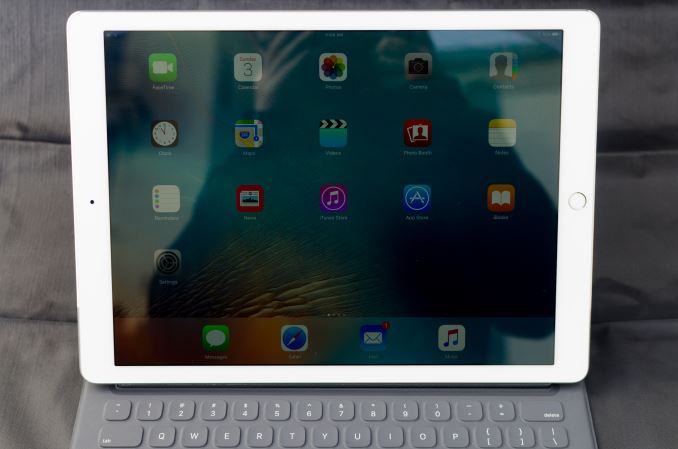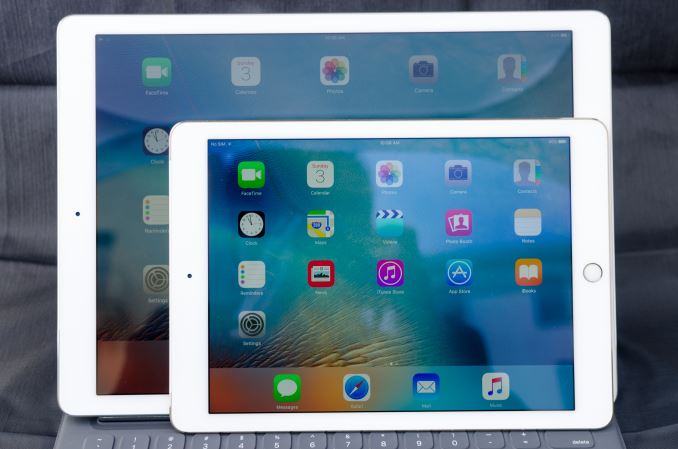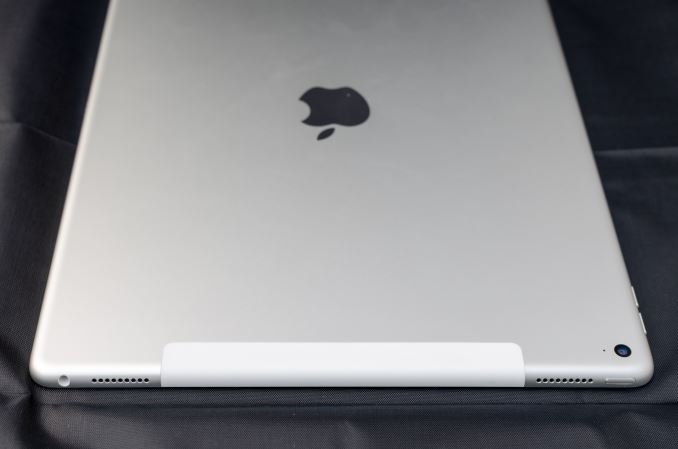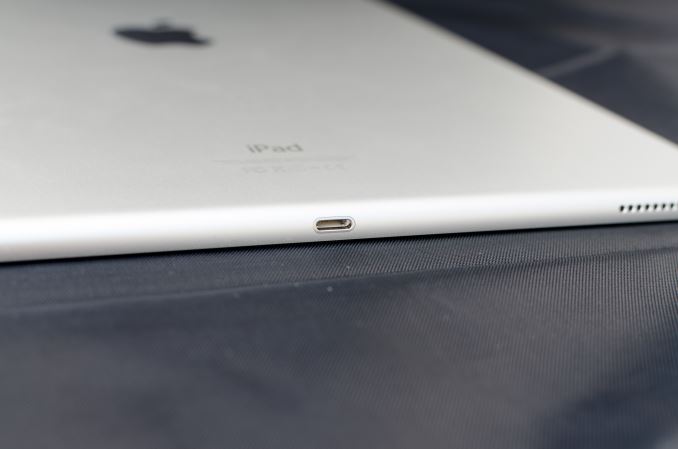The Apple iPad Pro Review
by Ryan Smith, Joshua Ho & Brandon Chester on January 22, 2016 8:10 AM EST
At this point it probably isn’t a secret that tablet sales have leveled off, and in some cases they have declined. Pretty much anywhere you care to look you’ll see evidence that the tablet market just isn’t as strong as it once was. It’s undeniable that touch-only tablets have utility, but it seems that the broader market has been rather lukewarm about tablets. I suspect at least part of the problem here is that the rise of the phablet has supplanted small tablets. Large tablets are nice to have, but almost feel like a luxury good when they’re about as portable as an ultrabook. While a compact laptop can’t easily be used while standing, or any number of other situations where a tablet is going to be better, a compact laptop can do pretty much anything a touch-only tablet can. A laptop is also going to be clearly superior for a significant number of cases, such as typing or precise pointing.
As a result, large touch-only tablets feel like they’ve been limited to home use as a computer away from the computer. Tablets are great when you’re on the couch or in bed, but once you get to this point there are some obvious questions as to whether it makes sense to drop $500+ USD on a tablet that seems to have relatively limited utility. The Surface lineup has been showing signs of growth, but in general the Surface is more of a mix between laptop and tablet rather than a tablet. I would argue that given the OS and overall design that the Surface and Surface Pro are really more laptop than tablet, even if at the hardware level the Surface Pro 4 and Surface 3 are basically tablets with kickstands and keyboard covers.
If you’re guessing that this means Apple has had some issues with growing sales of their iPad lineup, you’d be right. From my first experiences with the iPad 3, I was impressed with the improved user experience for things like web browsing and other smartphone tasks, but I never really felt like it made enough sense to get one for myself. The iPad Air 2 was once again impressive and I felt like I could recommend it to other people that wanted a tablet, but I personally struggled to come up with a reason why I would buy it.
This brings us to the iPad Pro. This is probably the first time Apple has seriously deviated from traditional iPad launches, putting together a tablet built for (limited) productivity and content creation rather than just simple content consumption, creating what's arguably the iPad answer to the Surface Pro. To accomplish this, Apple has increased the display size to something closer to that of a laptop, and we see the addition of a stylus and a keyboard cover for additional precision inputs. Of course, under the hood there have been a lot of changes as well, so the usual spec sheet can be found below to summarize those changes.
| Apple iPad Air 2 | Apple iPad Pro | |
| SoC | Apple A8X 3 x Apple Typhoon @ 1.5GHz |
Apple A9X 2 x Apple Twister @ 2.2GHz |
| GPU | PowerVR 8 Cluster Series6XT (Apple GXA6850) |
PowerVR 12 Cluster Series7XT |
| RAM | 2GB LPDDR3 | 4GB LPDDR4 |
| NAND | 16/64/128GB | 32/128GB |
| Display | 9.7" 2048x1536 IPS LCD | 12.9" 2732x2048 IPS LCD |
| Size and Mass | 240 x 169.5 x 6.1mm 437g WiFi, 444g LTE |
305.7 x 220.6 x 6.9 mm 713g WiFi, 723g LTE |
| Camera | 8MP Rear-Facing, f/2.4, 1.1 micron, 1.2MP Front-Facing, f/2.2 | |
| Battery | 27.3Wh | 38.5Wh |
| Launch OS | iOS 8 | iOS 9 |
| Cellular Connectivity | MDM9x25 Category 4 LTE + GPS/GNSS in Cellular SKU | |
| Other Connectivity | 2x2 802.11a/b/g/n/ac + BT 4.2, Apple Lightning | |
| SIM | Optional NanoSIM | |
| Price | $499/599/699 16/64/128GB | $799/949/1079 32/128GB/128GB LTE |
At a high level, the iPad Pro gains a larger display with a higher resolution, more memory, a new SoC, and a larger battery to compensate for the change in display size. In addition to these changes, the iPad Pro also brings noticeable changes to the speakers, with an increase to four speakers which allow the iPad Pro to compensate for device orientation when projecting stereo audio.
Design
The most immediate change that you can see in the iPad Pro is the sheer size. The 12.9” display of the iPad Pro basically makes it feel like you’re carrying a laptop around. I would argue that this doesn’t actually affect the portability of the iPad Pro, but this is mostly because the iPad Air 2 was something that I only carried in a backpack to begin with. People carrying their tablets in a small bag, purse, or even just in their hands will notice the difference, so the change in size might be more or less noticeable depending upon how you carry things around.
The increase in size does affect weight. After significant use, I honestly don’t think the mass is a significant issue. It does feel heavier than the iPad Air 2, but the mass distribution is such that there isn’t a ton of battery hanging out at the edges of the device where it’ll affect the moment of inertia. This does raise the question of whether Apple included enough battery for sufficient battery life, but that’s a question best left for the rest of the review.
In terms of design, the iPad Pro is rather unremarkable if you’ve ever seen an iPad Air before; it is for all intents and purposes a bigger iPad Air. On the front, the display dominates, with some bezels on the sides and top. The top has the front-facing camera, and the bottom has the home button with TouchID.
Looking at the sides of the tablet, the top edge has the power button and 3.5mm port, along with two of the four speakers. The right edge has the volume buttons, and the bottom edge has the Lightning port and the other two speakers. The left edge is mostly empty, but contains the Smart Connector for the Smart Keyboard and similar accessories.
The back of the tablet is mostly unremarkable as well. For the LTE model, an RF window is visible on the top of the device to allow LTE and other connectivity to function. For the WiFi variants, it looks like the bottom display bezel and the bottom two speakers are the RF windows, so there aren’t any visible areas that indicate where the WiFi antennas are.
Overall, the iPad Pro feels like an iPad, with nothing all that remarkable beyond its size which is carried well. I never really noticed the mass or size of the iPad Pro even if it is clearly larger and heavier than the iPad Air 2. I also didn’t notice any issues with the back cover flexing, but given enough pressure on the back cover pretty much any device this large will see some screen distortion or bending. The iPad Pro does technically regress in thickness compared to the iPad Air 2, but I never noticed the difference in practice, especially when the larger display is really what matters more.
















408 Comments
View All Comments
ghostbit - Friday, January 22, 2016 - link
I like iPads as thin clients.wolfemane - Friday, January 22, 2016 - link
The article was a great read and very thorough. Thank you Joshua Ho, Brandon Chester & Ryan Smith. I look forward to the next article!nrencoret - Saturday, January 23, 2016 - link
It seems cliché in Apple product reviews to mention bias, but this article fits the cliché quite well.The selective comparisons with other tablets are alarming. As others pointed out, no other product with a stylus has been thoroughly reviewed. A bare mention of the SP3 pen is all we get whilst all of the cons explored in the stylus section have no counterpoint as to how strong Surface tablets (and even Samsung devices) are at note taking (the exporting woes with the iPad come to mind). Even more troubling is the keyboard section where anyone who has decent tech knowledge knows how big of an improvement is the SP4 keyboard just to have it conveniently ignored in the conversation. The section is even worse when one considers the lack of angle adjustments, stability issues and cumbersome setup of the iPad keyboard are compared to the SP. Not to say a thing about the lack of mouse input which makes the whole desktop use uncomfortable. Finally the bland treatment given to the charge time of the tablet is inexcusable.
On the plus side, the SOC section is impeccable.
But the overall falling (as with all of Joshua's Apple writings) is a self-fulfilling prophecy: he likes the iPad and excuses or dismisses the the product's failings and conveniently never discusses what other products+software do better. Happy you like your iPad and you've written a good essay as to why its a good device for you, but this, a professional unbiased review its not.
10101010 - Saturday, January 23, 2016 - link
As a Note 8 and 12.2 owner, I can say the "exporting woes" of the iPad Pro are absolutely trivial in comparison. Samsung completely fumbled building a pen app ecosystem. This will not be the case with the iPad Pro.When it comes to the Surface Pro, we need to talk about how Windows is a broken platform and few developers want to write apps for it anymore. Even Microsoft's own developers don't like Windows anymore and are writing their latest software for other platforms using open source frameworks such as Electron.
Let's not forget to mention that the Surface Pro hardware, firmware, and drivers are so flaky that there is "SurfaceGate":
https://www.thurrott.com/mobile/microsoft-surface/...
And we also have the endless "whack-a-mole" adventure that is trying to maintain some semblance of data privacy/security with Windows 10 and its factory installed malware and forced updates.
One could on. You know, so things are more "professionally unbiased".
royalcrown - Sunday, January 31, 2016 - link
Thank you, for I am racing this on a Note 12.2 now. The S Pens have good hardware but their size sucks and the apps for them are too dumbed down or too many steps just to take simple notes.name99 - Saturday, January 23, 2016 - link
Hmm. For a team that is supposedly so blindly in love with Apple, they seem remarkably ignorant about how to actually DO things. For example, here's how you export those Pencil written notes:you install an iOS app called PrinterPro https://readdle.com/products/printerpro OR
https://itunes.apple.com/us/app/printer-pro-print-...
This installs a share sheet into iOS which allows you to "print" to a variety of real or virtual printers. One of these virtual printers is, of course, a PDF printer which just create a PDF file.
THIS sort of thing is why Apple folks get so irritated with Windows/Linux folks. You keep claiming that something or other cannot be done (on OSX or iOS) but 95% of the time your actual complaint is "I don't know how to do ... on OSX/iOS; therefore obviously it can't be done because I know everything in the universe about computing". There's more than one way to do things, folks, and just because the Windows way is some weird voodoo of "install a driver; go into some dialog that hasn't been updated since Windows 95; change three settings in the registry; now you can create PDFs" doesn't mean that iOS makes you do the same thing if you want to create PDFs.
Share sheets are the generic inter-app communication mechanism for iOS, and anyone who was actually familiar with the platform would immediately think that this was the sort of place to look to solve the problem.
As for Printer Pro being "unsupported". Well, my version is actually free because Apple liked the product so much they sponsored it being free on the app store for two weeks or so. I don't think they're likely to yank it from the store...
Should this be part of the OS? Well, plenty of thing should be part of every OS. How long did it take WINDOWS to get a Print to PDF option?...
My guess is that at some point it will be wrapped into the standard iOS bundle of features, but that right now Apple have higher priorities, and the third party solution works very well without the sorts of security, stability, or power concerns that might compel Apple to move other features into the base OS more rapidly.
royalcrown - Sunday, January 31, 2016 - link
True, but it'seems stupid in this day of very common WiFi printers that you can'take just install an app from the app store that is from the printer manufacturer that allows IOS to print directly (No Airprint nonsense). How a out the fact that it took until IOS 8 or 9 to attach a PDF to an email.I like both companies and use both, but this is the kind of stupid crap that apple does that gives haters a "Foot in the door". It's why I switched out my IPad 3 for a Note at the time.
bitbank - Saturday, January 23, 2016 - link
Small correction to your comparison of ARM to x86 ISA: you said "By comparison, the ARM ISA has no direct equivalent to this instruction. Any instruction like leal/leaq is going to take multiple instructions.". This is incorrect. ARM with its 3-operand instructions usually takes fewer instructions compared to Intel. In this case, there is a single instruction which is more powerful than the Intel equivalent -> ADD R1,R2,R3,LSL #2. This is effectively R1 = R2 + 4*R3. The barrel shifter and 3-operand instructions mean you can do more work than the Intel ISA allows. Individual ARM instructions are on average longer than Intel instructions, but you usually need fewer of them to accomplish the same task.JoshHo - Saturday, January 23, 2016 - link
Fiora Aeterna has also helpfully pointed this out. I've since updated the article to resolve this inaccuracy and use a (hopefully) better example.name99 - Sunday, January 24, 2016 - link
We can be more precise about this. Experiments have been done about the density of code and it is a fact that ARM-v8 is very slightly DENSER than x64 code. ARM-v7 was slightly less dense than 32-bit x86 code.The barrel shifter is not relevant to ARM-v8 (neither is predication). What is relevant is a very cleverly designed ISA that actually exploits what we've learned about usual code patterns over the past 30 years or so. So ARM has load and store register pair, or just enough predication-like instructions (CSEL and the concatenated branch conditions), or a way to distinguish between instructions that do and don't set branch conditions, or an encoding of literals that is, as matter of empirical reality, substantially denser than a flat encoding. All these make for a substantially denser ISA than the traditional load-store type ISA of something like MIPS or POWER.